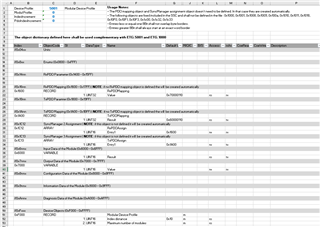Hi everyone,
I re-create a new post, I though I resolved my issue, but not.
I am struggling to create a slave project from scratch with the F28388D.
All the EtherCAT examples are working. Now I would like to send one 16 bit variable called "Value" and receive one 16 bit variable "Result". The documentation ET9300 is far from straightforward for me.
- I start SSC and create a New Project. Select the TI F2838x CPU 1 Sample (Includes Sample Application)

Got the message:
"Patch file cannot applied because configuration version (5.12) not match current SSC version "
I continued...
- I set the VENDOR_ID, VENDOR NAME VENDOR IMAGE and DEVICE_NAME:

- Create a new application description file (Tool-> Application->Create new)
An Excel sheet open.
I filled it as below:
- I close the excel

- Create the slave files (Project -> “Create new Slave Files”)
- Change the source folder for the cpu1_echoback_solution ( this is the one where I want to start with)

- Open CCS, Project->Import CSS Project ->f2838x_cpu1_echoback_solution
- Check ecat_def.h, the VENDOR ID is the same as the SSC Slave setting.
- Remove the old CPU1_echoback_solution.,.h and Object.h and just keep my "new app"

- Compile, everyhting is good.
- Now I have to implement the input and output mapping in my New App.c:
uint16_t j = 0; uint16_t *pTmpData = (uint16_t *)pData; uint16_t data; for (j = 0; j < sTxPDOassign.u16SubIndex0; j++) { switch (sTxPDOassign.aEntries[j]) { /* TxPDO */ case 0x1A00: // 8 bits data = Result0x6000; * (volatile uint16_t *)pTmpData = data; break; }
I received the error:
I don't understand what is wrong, Result0x6000 should be generate by SSC using my excel sheet.
Thank you




